Gregory A. Fournier's Blog, page 10
November 5, 2020
Alex Karras--Basketball Bully?
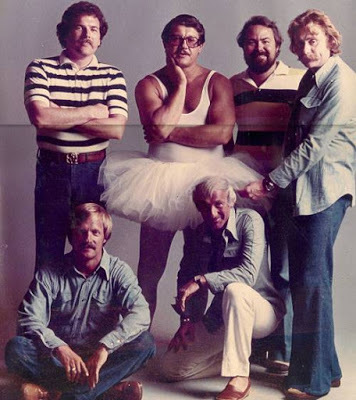 Anybody know what this publicity shot was for? I recognize Alex Karras and Merle Olsen. Who are the other guys? I think the guy with his legs crossed might be Jack Nicklaus.
Anybody know what this publicity shot was for? I recognize Alex Karras and Merle Olsen. Who are the other guys? I think the guy with his legs crossed might be Jack Nicklaus.Over the spring of 1963, Detroit Lion Alex Karras was waiting to hear his fate over NFL gambling allegations. He continued to go about his life as normally as possible. In the off-season, the Lions' public relations department organized a series of exhibition basketball games in the greater Detroit area to raise money for worthy causes with the side benefit of selling Lions' season tickets. The games were meant to be fun, with the Lions players pulling gags, breaking the rules, and ignoring the volunteer referees much like the Harlem Globetrotters but without the talent or precision timing.
On March 24, 1963, The Detroit Free Press reported that during a Lions exhibition game in Bronson, Michigan on March 19th Alex Karras hit community player Darian Wiler with a "deliberate backhand blow to the neck that left him flat on the floor for five minutes." After Karras was pulled from the game and sent to the showers, the rest of the Lions stuck to playing the basketball game without any further antics.
Another roughing incident occurred several days later in Belleville, Michigan which broke up the game before the clock ran out. The Lions' opponents were an alumni team of former Belleview High School basketball athletes who wanted to prove they still had what it takes before the hometown crowd who was rooting them on.
Former local basketball star, twenty-year-old Gerald Linderman told the Free Press that Alex Karras roughed him up on the court and slugged him when he attempted to shake hands with him in the locker room. Karras denied the incident, "I didn't get hit and I didn't hit anybody. I can't understand what all the trouble is about. There was no real trouble."
 Detroit Lions Logo 1961-1969
Detroit Lions Logo 1961-1969Spectators reported that they hoped to see a fun Lions' celebrity fundraiser for Little League baseball, but Karras was playing roughhouse basketball more like a football game or a professional wrestling match.
"Before me," Linderman said, "(Karras) hit one guy with a forehead and he elbowed another in the mouth; then, he got all over me just before the game was ended. The game took a turn for the worse when our team's biggest player, Fritz Steger (6' 3"/220#), was sent to the showers after he bumped Lion Wayne Walker, and Walker hit him with a basketball squarely in the face from only five feet away.
"Karras came up to me and said, 'You gave me an elbow for the last time. I'm gonna give you one in the mouth'. We swung at each other a couple of times as I tried to back away to protect myself. He tackled me giving me a cut over my right eye. The (organizers) called off the game."
One of the referees Richard Duffield, a teacher at Livonia High School, was an eyewitness. "Linderman had his hand out and said he was sorry thinking Karras would shake it, then he pinned Linderman against the wall. (Karras) backed off, changed his mind, and hit him hard in the jaw. Thirty minutes later, Karras apologized saying he was already in enough trouble.
A couple days after the unflattering Free Press article ran, the Detroit Lions' public relations office had club trainer Millard Kelly and a couple of players including Karras make a press statement about their promotional basketball program and the incident.
Kelly told the local Detroit media, "You get some (players) who want to make it a friendly exhibition game and some who are gung-ho about winning. The gung-ho ones are kids out of high school a few years that are rusty but ready to show the hometown crowd they can still play basketball and aren't going to be pushed around by any pro football bullies."
Detroit Lion end Gail Gogdill said of the Belleville scuffle, "We want to put on a good show, but there are always some of the hometown team who want to beat the big, bad Lions. They think they can pop a few elbows. Wayne (Walker) and Alex (Karras) were elbowed all the time. We pulled our stunts like flying wedges, fake field goals, holding each other on our shoulders to make a shot. We signed autographs at halftime and everybody had a good time."
Karras' final words on the subject were "You know how guys are sometimes? He (Linderman) banged me in the throat twice with his elbows, and I told him 'Kid, that's enough. Cut it out now', so he bangs me again. So, I'm the bully?"
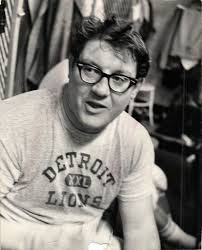 Karras in locker room interview.
Karras in locker room interview.The fracas undoubtedly reached the desk of NFL commissioner Pete Rozelle, as did the news of the professional wrestling match Karras was scheduled to have with mauler Dick the Bruiser at Detroit's Olympia Stadium on April 29, 1963. Karras was left to twist in the wind until April 17th when Commissioner Rozelle called and informed him he was suspended for the 1963 NFL season after admitting gambling on NFL games.
On April 21st, Karras was contacted by The Detroit Free Press for comment. The Lion's beleaguered, defensive lineman said he felt the suspension was unfair but there was nothing he could do about it. To play down his simmering resentment, he added, "I even got a call from Belleview. They said they were forming a Dick the Bruiser fan club. They're coming down to see me take a beating."
The Bellevue boosters were not disappointed.
October 30, 2020
Docuartist DeVon Cunningham--a Detroit Art Treasure
 DeVon CunninghamBorn in Tuscaloosa, Alabama on February 21, 1935, DeVon Cunningham began his art training at the tender age of eleven when he won a scholarship to the John Herron Art Institute in Indianapolis, Indiana. Part of his training was a two-week, all expenses paid seminar to study in Italy.
DeVon CunninghamBorn in Tuscaloosa, Alabama on February 21, 1935, DeVon Cunningham began his art training at the tender age of eleven when he won a scholarship to the John Herron Art Institute in Indianapolis, Indiana. Part of his training was a two-week, all expenses paid seminar to study in Italy.He continued his art training at the Detroit Center for Creative Studies and the Birmingham Bloomfield Art Center. Cunningham went on to complete a bachelor's degree from the Detroit Institute of Technology and a master's degree from Wayne State University.
When he wasn't working as a marketing executive for Detroit Edison, DeVon was painting. Over his long career, DeVon's paintings have appeared in many galleries including eleven one-man shows, and his work hangs in many private and public art collections--the most notable being the Portrait Gallery of the Smithsonian Institute.
In 1969, DeVon Cunningham achieved national recognition when he painted the mural of the Black Christ on the dome of St. Cecelia Catholic church at Livernois and Burlingame in Detroit. This work featured a twenty-four-foot, brown-skinned image of Jesus with six multiethnic angels beside him serving high mass. The church's parishioners were mostly African Americans from the neighborhood. The mural was a welcomed addition to this French Romanesque church built in 1930 before the ethnicity of the neighborhood changed.
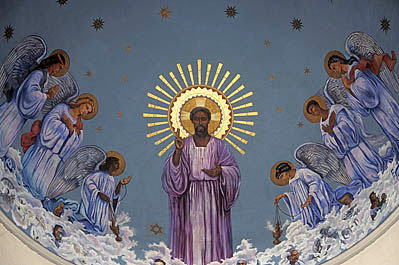
A national controversy erupted when the mural appeared on the cover of Ebony magazine in March 1969. Twenty-five years later on December 25th, 1994, the mural once again became the topic of controversy when the New York Times featured the church mural on Christmas Day. Reverend Raymond Ellis, rector of St. Cecelia's, responded to the criticism in a Detroit Free Press interview.
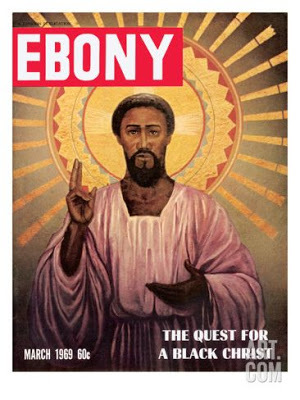 "Black parishioners have a legitmate complaint when they walk into a church to worship and everything is white. Christianity forces people to accept Western European culture.
"Black parishioners have a legitmate complaint when they walk into a church to worship and everything is white. Christianity forces people to accept Western European culture."The historical Christ was Hebrew, a Jew from the Middle East. He might have had dark skin; he might have been fair. But Christ is the head of the church, he is God, and he is any color people want him to be."
Cunningham's commissioned portraits of prominent Detroit community leaders include Martha Jean "The Queen" Steinberg, a WCHB radio personality active in Detroit's African American community; Coleman Young, the city's first black mayor; Abe Burnstein, Detroit's reputed Purple Gang boss during Prohibition; and many others.
The most mysterious portrait Cunningham has painted is of Motown founder Berry Gordy Jr. It was unveiled at Gordy's Boston-Edison mansion as a birthday present from his sister Anna Gordy Gaye--the wife of singer Marvin Gaye. Berry was quite moved and lauded the painting of him dressed up like Napoleon. Somewhere along the line, someone suggested that it might not be a compliment to be compared to Napoleon, and the painting disappeared. (More on that story appears in the link at the end of this post.)
Cunningham's portraits gave way to what he calls docu-art that informs, instructs, and involves the viewer. His work combines symbolism with cultural iconography that leaves the viewer with a montage of images to ponder. DeVon's art not only appeals to the eye but also to the mind.
DeVon's jazz musician series typifies much his later work. Historically, Detroit was instrumental in the 1920s through the 1950s for providing African American jazz and blues musicians venues to perform and make a living through their music. To document the historic relationship of Jews and African Americans, Cunningham painted legendary performers like Theolonius Monk, Louie Armstrong, Billie Holiday, and Miles Davis, who performed in Detroit's legendary nightclubs owned by Jewish empresarios who hired black acts when other venue bookers wouldn't.
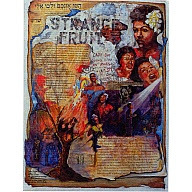 Billie Holiday docu-artAt the age of eighty-five, DeVon Cunningham continues to produce significant art that remains relevant in our changing times. He has a distinguished body of work and presently is working on a commission for the Spill the Honey foundation, a group that emphasizes the shared legacy of Jewish people and African Americans seeking historical truth and social justice through educational and artistic programs.
Billie Holiday docu-artAt the age of eighty-five, DeVon Cunningham continues to produce significant art that remains relevant in our changing times. He has a distinguished body of work and presently is working on a commission for the Spill the Honey foundation, a group that emphasizes the shared legacy of Jewish people and African Americans seeking historical truth and social justice through educational and artistic programs.With over sixty years of artistic achievement, ask people in the contemporary Detroit art world who DeVon Cunningham is and the likely response will be "Who?" What a shame.
Berry Gordy's Lost Portrait Martha Jean the Queen
October 27, 2020
The Evolution of America's Patriotic Images: Yankee Doodle, Uncle Sam, Miss Columbia, and Lady Liberty
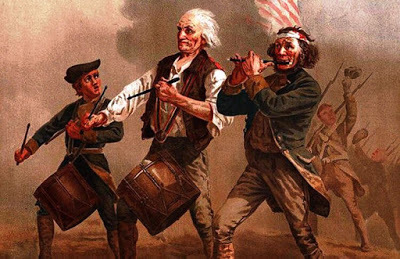 Originally titled Yankee Doodle Dandy, The Spirit of '76 was painted in 1876 by Archibald MacNeal Willard for the centennial celebrations in Philadelphia.
Originally titled Yankee Doodle Dandy, The Spirit of '76 was painted in 1876 by Archibald MacNeal Willard for the centennial celebrations in Philadelphia.Today, the most internationally recognized personification of the United States is Uncle Sam, but it wasn't always so. Before and during the Revolutionary War, the British Red Coats characterized ramshakle colonial soldiers as Yankee Doodle Dandies. It wasn't a compliment. The rousing British drinking song portrayed colonists as foppish, anti-royalists impugning their manhood.
The colonists were able to co-opt the insulting song and make it their own. Taking the song's melody, Edward Bangs--a Harvard University sophomore by day and a Minuteman by night--wrote fifteen new verses to the British song in 1775 and circulated the lyrics throughout New England. Yankee Doodle Dandy went from being an insult to a song of American national pride.
On September 7, 1813, Uncle Sam became the official nickname and image for the United States government. The name is attributed to cattle tender and meat packer Samuel Wilson. He supplied oak barrels of meat to the United States government for rations during the War of 1812. His workers stamped US on his government shipments, and he became known locally in Troy, New York as Uncle Sam. Soldiers soon picked up on the name.
Early on, the image of Uncle Sam did not have a standard appearance. Popular political cartoonist Thomas Nast is credited with the first image of Uncle Sam in a November 20, 1869 editorial cartoon in Harper's Weekly supporting the Fifteenth Amendment for universal sufferage. Uncle Sam (symbol of the government) and Columbia (symbol of the country) are hosting a Thanksgiving dinner for a group of diverse immigrants. Nash's Harper's Weekly editorial cartoon images of Uncle Sam helped establish the patriotic icon we know today.
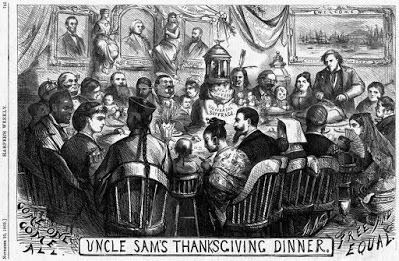
The image we all recognize as Uncle Sam evolved over time. The long and lanky man with the white goatee and white hair, dressed in red and white striped pants, a dark blue frock coat, a white top hat with a blue starred band, and a red bow tie was the creation of James Montgomery Flagg for the famous 1917 World War I United States Army recruiting poster which was used again during World War II. Millions of copies were distributed establishing Uncle Sam as the worldwide symbol of American patriotism and pride.
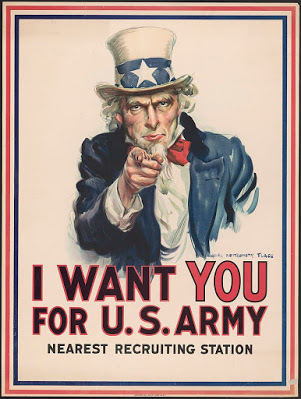
The earliest known personification of pre-United States appeared in 1738. Miss Columbia was the embodiment of liberty. European nations used the term "Columbia" to refer to the New World and then the thirteen colonies, based on the mistaken belief that Italian explorer Christopher Columbus discovered America. Miss Columbia's image was depicted as a strong, classical woman modeled after Greek goddess Athena and infused with a healthy dose of Americanism. She became a central figure in the narrative of early America, its values, its expansion, and its promise of establishing the American ideals of liberty and justice for all.
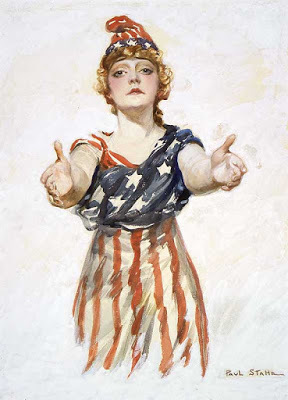 Columbia's image was often seen in political cartoons in the nineteenth and early twentieth century, but her dominance as America's favorite female icon was challenged in 1886 by the installation of the Statue of Liberty. The two iconic images co-existed for thirty years, but the personification of Columbia fell out of favor with the issuance of Liberty Bonds in support of the World War I war effort which had The Statue of Liberty's image printed on them.
Columbia's image was often seen in political cartoons in the nineteenth and early twentieth century, but her dominance as America's favorite female icon was challenged in 1886 by the installation of the Statue of Liberty. The two iconic images co-existed for thirty years, but the personification of Columbia fell out of favor with the issuance of Liberty Bonds in support of the World War I war effort which had The Statue of Liberty's image printed on them.When Columbia Pictures chose their trademark in 1924, they created a blended version of Miss Columbia with The Statue of Liberty pose, doing neither icon any favors. To compound Miss Columbia's troubles, some of America's most iconic coinage bore the image of Lady Liberty, who became the favored personification of liberty.
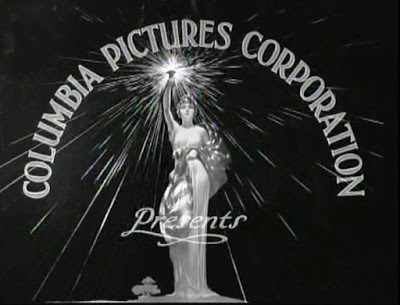
Columbia endures as the name of many cities and streets throughout the United States, as well as Columbia University in New York, Columbia Records, Columbia Pictures, Columbia Broadcasting System (CBS), and the name of our ill-fated space shuttle which exploded in mid-air on February 1, 2003.
Contemporary cartoonist for The Independent Weekly in Durham, North Carolina D.C. Rogers may have expressed it best, "One of the reasons Miss Columbia has declined is that The Statue of Liberty has risen." The most famous American monument to liberty was a gift from the people of France.
 America's enduring symbol of freedom--The Statue of Liberty.
America's enduring symbol of freedom--The Statue of Liberty.Lady Liberty's image also has a long and distinguished history on American coinage. A one cent coin was struck in 1793. Liberty's cameo image was considered unattractive with a wild mane of hair and a balding, sloped forehead. It was quickly retired making this coin one of the most sought after American coins for collectors.
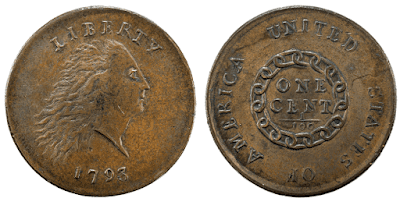
In 1795, the Liberty Draped Bust silver dollar showed an attractive, middle-aged Lady Liberty with flowing hair held back with a decorative bow. She is surrounded by stars representing the number of states. This image of Lady Liberty was minted from 1795 until 1804.
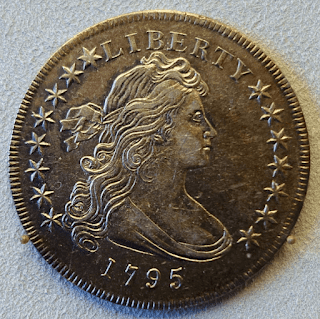
In 1878, George T. Morgan designed what is known as The Morgan Silver Dollar, prized by collectors because of its size and weight. The model for the coin, Anna Willness Williams, became known as the "Silver Dollar Girl." Morgan designed a cameo profile with Liberty's beautifully quaffed hair in a Phrygian cap which signifies freedom and the pursuit of liberty. This silver dollar was minted until 1921.
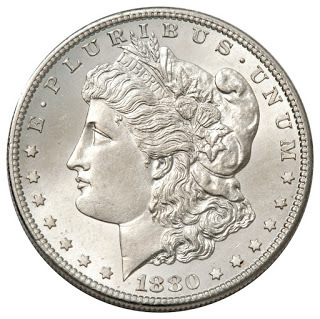
The Walking Liberty half dollar was minted from 1916 until 1947. This silver coin is rich with symbolism. Lady Liberty walks towards the dawn of a new day. She carries a bouquet of laurel and oak representing military and civil victories of the nation. Her outstretched arm imparts the spirit of liberty to others. She is clothed in a lovely, flowing gown representing the American flag, and she is wearing a Phrygian cap. The coin was reissued again for collectors because of its exceptional beauty.
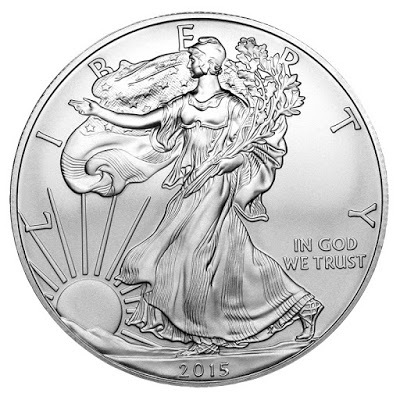 Rosie the Riveter--Another American Icon
Rosie the Riveter--Another American Icon October 22, 2020
California Kid/Midwestern Heart
 I'm proud to announce that my daughter Nicole Fribourg is a romance novelist. I asked her to write a brief guest post about her motivation.It's been wonderful to have a foot in one state and a toe in another. I've always been an observer of people, curious about what makes them do what they do and think what they think. The Michigan blizzard of 1979 drove my parents to leave the Detroit area for sunny San Diego. I grew up 2,400 miles away from Detroit, but Vernor's ginger ale was always in our fridge and I know what a Boston Cooler is.
I'm proud to announce that my daughter Nicole Fribourg is a romance novelist. I asked her to write a brief guest post about her motivation.It's been wonderful to have a foot in one state and a toe in another. I've always been an observer of people, curious about what makes them do what they do and think what they think. The Michigan blizzard of 1979 drove my parents to leave the Detroit area for sunny San Diego. I grew up 2,400 miles away from Detroit, but Vernor's ginger ale was always in our fridge and I know what a Boston Cooler is. When my family visited Michigan in the summers, we always went by car. We drove across the California mountains, the Southwestern deserts, the Great Plains, the Midwest, and the Great Lakes region--often on the back roads off the interstate. We'd have an adventure of the sites, sounds, smells, and tastes along the journey--not to mention the many people we encountered.
This treasure trove of memories and images I use to create my characters to make them more textured and relatable to readers. I write through the lens of the experiences and the diverse people I've met along the way. My wish is that my books take readers on an entertaining journey to better understand themselves and their personal relationships.

Check out my latest romance novel: "Fixing Flynn"
For a list of my current novels, see my Amazon Author page: amazon.com/author/nicolefribourg
Join my mailing list for information about my upcoming projects: https://nicolefribourg.wixsite.com/nicolefribourg
October 17, 2020
Martha Jean the Queen—Patron Saint of Blue Collar Detroit
 Martha Jean the Queen painted by DeVon Cunningham (1976)
Martha Jean the Queen painted by DeVon Cunningham (1976) A couple of radio executives from WCHB-AM in Detroit were driving through Memphis on business in 1963 when they heard the voice of Martha Jean the Queen (MJQ) on their radio. They liked the Queen’s Southern accent and her facile dee jay patter. These Northern radio men were in the South shopping for an African American disc jockey that could help WCHB-AM (Inkster, Michigan) capture the vast Detroit Black radio market. Most Black Detroiters had Southern roots, so it seemed like a sensible marketing strategy.
MJQ was number one in her Memphis time slot which was a notable achievement in the Jim Crow South for a Black woman disc jockey—a testament to her ability to draw an audience. These Northern radio execs called Martha Jean at WDIA–AM and offered her a raise of $30 a week if she would take her radio program to Detroit. MJQ was a recently divorced, single mother of three daughters who didn’t want to move, but Martha Jean had custody and needed the extra income, so she took the job.
Martha Jean Jones was born in Memphis and graduated from a Catholic school. She began nursing school but the harsh realities of life and death pushed her into business school. As fate would have it, Martha fell in love with jazz trumpeter Luther Steinberg, married him, and had three daughters in quick succession. She saw her life as the manifest destiny of a young Southern Black woman, a child of poverty, followed by a volatile marriage, bondage to babies, and a lifespan of degradation by Whites.
Luther Steinberg was struggling in the music business when he became abusive to Martha Jean, so she divorced him. “There are two things I can’t stand,” she said commenting on her failed marriage in a Detroit Free Press feature article on January 10, 1982, “a man who is cheap and a man who runs around on his woman.”
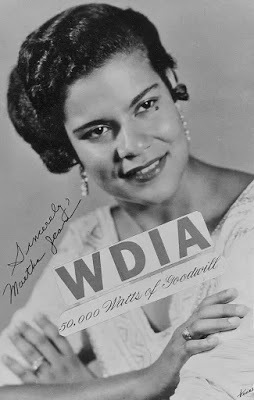
Martha Jean used the power of positive thinking to pick herself up and provide for her children. “We should all try to see the beautiful side, the positive side (of life),” she said, “but the ugly side has been with us as a people for a long time and with me personally as a divorced woman with children.”
Martha Jean Steinberg became a receptionist for Memphis radio station WDIA-AM. Because she had a pleasing manner dealing with everyone who walked through the door, the station manager gave her a try on the radio in 1954 as a substitute for an ill disc jockey and she stayed there for nine years learning the radio business and earning the title The Queen. Her patented tagline "You betcha!" after she read advertising copy was like money in the bank for advertisers.
In a May 21, 1967 Detroit Free Press Sunday interview, MJQ was asked what her radio name “The Queen” meant to her. In figurative deejay fashion she answered, “I was written in the sands of time 5,000 years ago, endorsed and smiled upon by the gods. I have a purpose, and I’m on my way to fulfill my purpose…. I am the Queen of the people, they are my purpose.”
When MJQ came to Detroit, WCHB wanted her to play easy listening rhythm and blues and read advertising copy. MJQ’s Homemakers Delight program ran from 10:00 AM until 12:00 PM for three years. One of her early challenges was the perception that she sounded too White to project the Black image over the airwaves. “I had to get down with it to prove I was Black enough and find my place in Detroit’s Negro community, so in many ways, I had to act and sound more colored than colored. Detroit had long been a haven for jazz musicians, so I introduced jazz to my musical lineup and my audience grew.”
MJQ became known for supporting women’s rights throughout the 1960s reminding blue collar wives when it was payday at the Ford plant or Great Lakes Steel—the two largest employers of Black men in the Detroit area. “Get that check from your man before it disappears, ladies.” Martha Jean was proud of herself for making it without "the crutch of a man.” She never forgot the desolation of being left alone with three daughters and no money. The Queen was an inspiration to her soul sisters in the audience.
Unsatisfied with her limited role at WCHB, MJQ jumped stations again when WJLB-FM offered her more money, air time, and freedom to co-produce her own programming. In addition to playing music, she added a fifteen minute call-in segment named Tasting Time where she gave her daily salute to blue collar people around the Detroit area.
In a Detroit Free Press feature article on October 23, 1966, MJQ explained her move, “WJLB-FM will give me a better opportunity to serve my people and do things for them. The secret of my success in Detroit are the people—the forgotten blue collar workers. I like and enjoy people. I feel a disc jockey has command of so many hearts and minds…. I give my listeners a positive reality and that surge of hope necessary to exist. I feel my day is in vain if I can’t touch someone or lift their spirits.
“In my own Southern way of talking, a lot of people started listening to me. My positive message gives people self-confidence to accomplish whatever is challenging them. I’d play blues, and between each bar of a song, I’d talk without interfering with the lyrics and say things like ‘Hey! You cats at Kelsey Hayes’ or ‘You guys in the hole on Ecorse Road’ when the Wayne County Road Commission was working on the roadway. These blue collar workers were listening on transistor radios at work, and it made them feel like somebody when I mentioned them or their place of work on the air. Soon, places all over town began asking me to give them a call out over the airwaves. My slogan was ‘You’re somebody, act like it’.”
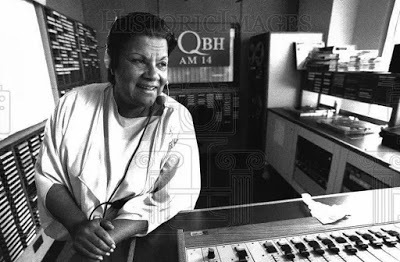
During the 1967 Detroit Riots/Rebellion, MJQ broadcast for 48 hours straight urging Black demonstrators to get off the streets and stay home. She helped police negotiate with armed Black Panthers barricaded in a house into surrending peacefully to avoid bloodshed because innocent women and children were inside. That terrible conflagration was transformative for Detroiters. From that moment onward, Martha Jean felt a responsibility to be a bellwether for her people. In the 1970s, MJQ moderated a show called Buzz the Fuzz with Detroit Police Commissioner John F. Nichols credited with improving police/community relations. Every Thursday from 7:00 PM until 7:30 PM, callers could ask Commissioner Nichols questions.
On January 11, 1971, MJQ gave a short scream into the microphone at noon, and then there was three hours of radio silence. Nine Black WJLB staff members—including MJQ—staged a sit-in by locking the studio door and barricading the plate glass front window of the station’s offices on the 31st floor of the David Broderick Tower. The on-air staff was all Black but management was all White. The staff charged that the outgoing station manager failed to live up to an earlier agreement to appoint a Black station manager to replace him. After all, WJLB’s listening audience was primarily Black. The sit-in strike ended at about 3:00 PM after attorneys for both sides met to settle the matter with Norman L. Miller being named as WJLB’s first Black station manager.
Three weeks later on February 2, 1972, Martha Jean had an on-air, religious epiphany. While doing her Inspiration Time program, she announced, “I was just touched by the Holy Spirit.” Then there was a brief pause. Pensively she continued, “It was as if something, a different entity, came through my soul and told me my mission is to help bring Jesus Christ to the people,” she explained. From that moment, MJQ shifted from Soul Mistress of Detroit to Radio Evangelist and began featuring gospel music.
 In 1972, Martha Jean became an ordained minister and established her own nondenominational church in 1974. She purchased a two-story house on Grand River Avenue with a $70,000 Kresge Foundation Grant and named her church The Home of Love. She set about fulfilling her mission to serve the downtrodden and forgotten people of Detroit. Her organization raised money and bought the house next door for a church community nursery and preschool for daycare to help young Black women earn a living and get a leg up on life. The $12,000 mortgage for the Joy Building was paid off in five years.
In 1972, Martha Jean became an ordained minister and established her own nondenominational church in 1974. She purchased a two-story house on Grand River Avenue with a $70,000 Kresge Foundation Grant and named her church The Home of Love. She set about fulfilling her mission to serve the downtrodden and forgotten people of Detroit. Her organization raised money and bought the house next door for a church community nursery and preschool for daycare to help young Black women earn a living and get a leg up on life. The $12,000 mortgage for the Joy Building was paid off in five years. MJQ left WJLB-FM on May 30, 1982 over a scheduling dispute. Their new station manager told Martha Jean he was switching her popular midafternoon time slot to their spiritual hour at 5:00 AM. The time change was unacceptable, and she wasn’t having any of it.
Two weeks later, MJQ signed with station WQBH-AM that specialized in Black-oriented religious and inspirational programming. She took over her familiar 11:00 AM to 2:00 PM afternoon time slot. The new job also came with a pay raise in line with her new status as station vice president and program director. Fifteen years later, MJQ formed The Queen’s Broadcasting Corporation and purchased WQBH for $4.1 million dollars becoming the first woman-owned radio station in the country. She financed the purchase on the strength of her radio personality, her lucrative radio contract income, and her advertising agreements.You betcha!
Martha Jean the Queen passed away at the age of sixty-nine from an undisclosed illness at 10:45 AM on January 29, 2000 in Detroit’s Harper Hospital. Upon learning of Martha Jean the Queen Steinberg’s passing, The Detroit News reported, “She was hailed as an inspirational force that motivated people and served as a conscience for those needing guidance. Her listeners were the common, everyday folks from Detroit who lived from paycheck to paycheck.” MJQ had a private funeral service and is buried in Detroit’s Elwood Cemetery.
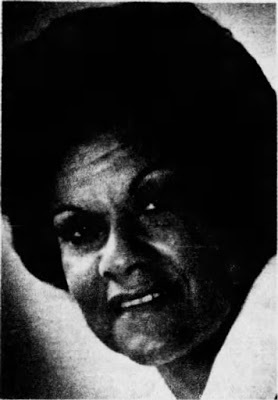
In her lifetime, Martha Jean the Queen was honored as one of rock music’s pioneering disc jockeys—the only woman so honored. She is also a member of the Black Radio Hall of Fame, Michigan’s Black Women’s Hall of Fame, the Rock & Roll Hall of Fame, and what she was most proud of, the founder and spiritual leader of the Queen’s Community Workers of America, that did charitable works around the city for Detroit's forgotten people.
In 1976, Detroit docu-artist DeVon Cunningham painted MJQ’s portrait where she is wearing a blue caftan and surveying the heavens. It commemorates her trip to the Holy Land with about seventy members of her Order of the Fishermen ministry. The painting is listed in the registry of the National Portrait Gallery of American Biography at the Smithsonian Institute.
October 4, 2020
FORNOLOGY Reaches One Million Hits
 Photo credit: Nicole Fribourg
Photo credit: Nicole FribourgIt took over nine years for my Fornology.com blog to reach one million hits at 2:45 pm, October 3, 2020. My first post was on May 3, 2011, since then I've written 460 posts on a variety of topics. My current goal is to reach 500 posts before I run out of sunlight. It should take me two or three more years.
Writing my Fornology blog over the past decade has been a joy. It has helped me build an audience for my books, establish my writing voice, and improve my editing skills. Another thing I like about blogging is it is a source of instant gratification when I get comments from readers.
But truthfully, the thing I most like about blogging is that it makes me appear smarter than I really am. I owe that to my wife Sue's proofreading help, and my ability to infinitely edit my posts to make them more correct.
Many thanks to all my readers. I appreciate everyone who reads and shares my posts. I could not have reached this milestone alone.
October 3, 2020
Detroit's Stroh's Brewing Company--With Its Days of Future Passed
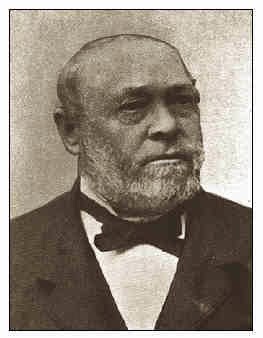 Founder Bernhard StrohAvoiding the German Revolution of 1848, Bernhard Stroh emigrated to the United States with knowledge of the brewing trade from his father Georg Friedrich Stroh--landowner and inn keeper. He was taught the Pilzen method of brewing a light-lager beer. In 1850--at the age of twenty-eight--Stroh established his basement brewery operation in Detroit with a $150 investment. Immediately, he started brewing Bohemian-style lager beer in copper-clad kettles that promoted the carmelization of the wort--unfermented beer--that made the beer lighter without reducing the flavor.
Founder Bernhard StrohAvoiding the German Revolution of 1848, Bernhard Stroh emigrated to the United States with knowledge of the brewing trade from his father Georg Friedrich Stroh--landowner and inn keeper. He was taught the Pilzen method of brewing a light-lager beer. In 1850--at the age of twenty-eight--Stroh established his basement brewery operation in Detroit with a $150 investment. Immediately, he started brewing Bohemian-style lager beer in copper-clad kettles that promoted the carmelization of the wort--unfermented beer--that made the beer lighter without reducing the flavor.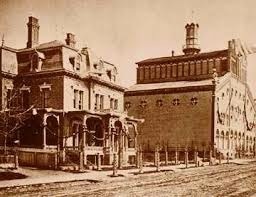 Stroh's home and first brewery buildingStroh's beer was sold door-to-door in beer buckets from a wheelbarrow, but soon horse-drawn wagons would be delivering his authentic German beer across town in barrels. Bernhard Stroh expanded his business in 1865 and adopted the heraldic lion emblem from the Kyrburg Castle in Germany. The lion icon is still visible in Stroh's product labeling.
Stroh's home and first brewery buildingStroh's beer was sold door-to-door in beer buckets from a wheelbarrow, but soon horse-drawn wagons would be delivering his authentic German beer across town in barrels. Bernhard Stroh expanded his business in 1865 and adopted the heraldic lion emblem from the Kyrburg Castle in Germany. The lion icon is still visible in Stroh's product labeling.Oldest son Bernhard Stroh Jr. assumed leadership of the brewing business when his father died on June 28, 1882 at the age of 59. The company patriarch was buried at Elmwood Cemetery in Detroit, Michigan. Bernhard Jr. introduced pasteurization and refrigerated rail cars which increased the shelf-life of their product and broadened their markets. Stroh's became the Detroit area's signature beer.
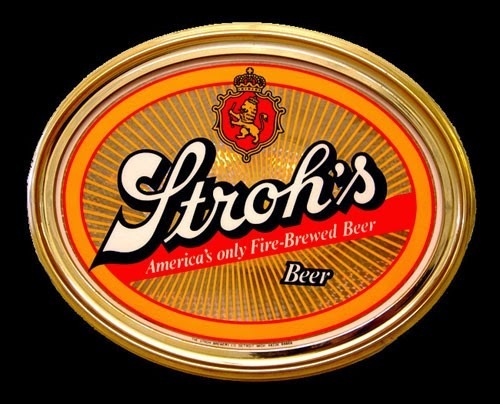
In 1908, Julius Stroh took over the family business from his brother. After a celebrated tour of Europe's finest breweries, Julius introduced direct flame--rather than stream--to heat the copper kettles. The company motto became "America's Only Fire-Brewed Beer" and part of the brand's labeling.
Prohibition was tough on the beer brewing industry and many breweries closed across the country. Rather than shut down and abandon their loyal workers, the company diversified and made near-beer (non-alcoholic), soft drinks, and ice cream. It is not unlikely that Stroh's Brewery may have made specially-ordered batches of the Real McCoy for Detroit's vast Speakeasy network. The country may have been dry, but Detroit was awash in booze. After Prohibition, the business grew and Stroh's became a regional favorite.
 What Detroiters recognize as Stroh's.A statewide strike halted beer production in 1958 which gave national brands a foothold in the Michigan beer market. In the 1960s, the Stroh family wanted to move the company into the national arena. They bought the Goebel Brewing Company--their rival across the street--in 1964. This increased Stroh's brewing capacity and solved the company's short term growing pains. Some twenty years later, Stroh's was sold in seventeen states. They needed even more brewing capacity, so they bought Schaefer Brewing Company--that had recently gone belly-up in the Miller beer advertising wars.
What Detroiters recognize as Stroh's.A statewide strike halted beer production in 1958 which gave national brands a foothold in the Michigan beer market. In the 1960s, the Stroh family wanted to move the company into the national arena. They bought the Goebel Brewing Company--their rival across the street--in 1964. This increased Stroh's brewing capacity and solved the company's short term growing pains. Some twenty years later, Stroh's was sold in seventeen states. They needed even more brewing capacity, so they bought Schaefer Brewing Company--that had recently gone belly-up in the Miller beer advertising wars.Then in 1982, Stroh's bought the Schlitz Brewing Company to become America's third-largest brewer--producing many well-known brands like Goebel, Schaefer, Schlitz, Old Milwaukee, Colt 45, and many others. In 1985, the 135-year-old-brewery on the East Side was simply outdated and had no room to expand. The following year it was imploded--a better fate than many of Detroit's factory ruins.
The Stroh's company business plan was to buy up struggling breweries and drive up the company's market share. Stroh's $500 million heavy debt load to buy Schlitz weakened the company's financial position and left them cash poor to compete with the onslaught of Anheuser-Busch and Miller Brewing Company's national marketing campaigns.
In 1990, Coors moved past Stroh's as America's #3 brewer. Stroh's market share dropped 50%. Beer analysts felt that Stroh's came to the light-beer party late. In 1973, Miller Brewing created Miller Lite beer and used macho football players and "tough guys" like pulp-fiction author Mickey Spillane. Miller's "Tastes Great/Less Filling" debate was a stroke of marketing genius. The Budweiser Clydesdales were a potent marketing image for Stroh's to compete with as well.
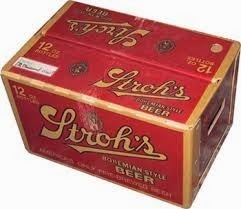
From the beginning of the company, Stroh's catered to working-class tastes at working-class prices. But Joe Six-Pack had moved on. Beer marketing shifted away from the product and onto the drinker. Advertising slogans like "This Bud's for You" and "It's Miller time--You earned it!" had great appeal to blue-collar beer drinkers. Coors' Silver Bullet promotion was the last straw.
In 1999--unable to compete in the twenty-first century--the 149 year-old brewer closed, and its assets were broken up and sold for the sum of their parts to Pabst Brewing and Miller Brewing companies. Many of the Stroh's brands were discontinued or sold off to other companies. Pabst acquired the well-known brands Colt 45, Schlitz, and Old Milwaukee--Miller got Mickey's Malt Liquor and the Henry Weinhard's line of beers.
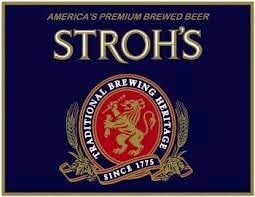 Today's Stroh's is produced by Miller Brewing Company. They don't use the special open-flame copper kettles, and the taste reflects the difference. The traditional Stroh's label read "America's Only Fire-Brewed Beer," but now it reads "America's Premium Brewed Beer."
Today's Stroh's is produced by Miller Brewing Company. They don't use the special open-flame copper kettles, and the taste reflects the difference. The traditional Stroh's label read "America's Only Fire-Brewed Beer," but now it reads "America's Premium Brewed Beer."As for the Stroh's family legacy, somehow the seventh generation has managed to lose over $700 million. Forbes magazine reports that by 2008, the family fortune was completely tapped out. Detroit's Pfeiffer Brewery and Johnny Pfeiffer
September 29, 2020
Victorian Theater and The Limelight
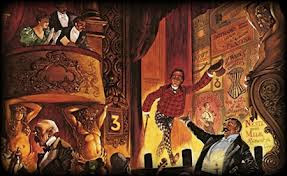
In the Victorian period, the expression in the limelight meant the most desirable acting area on the stage, front and center. Today, the expression simply means someone is getting public recognition and acclaim.
The limelight effect was discovered by Goldsmith Gurney in the 1820s based on his work with an oxy-hydrogen blowpipe. Scottish inventor, Thomas Drummond (1797-1840), built a working model of the calcium light in 1826 for use in the surveying profession.
The calcium light was created by super heating a cylinder of quicklime (calcium oxide) with an oxy-hydrogen flame that gives off a bright light with a greenish tint.

Eleven years later, the term limelight was coined to describe a form of stage illumination first used in 1837 for a public performance at the Covent Garden Theatre in London.
By the 1860s, this new technology of stage lighting was in wide use in theaters and dance halls around the world. It was a great improvement over the previous method of stage lighting, candle powered footlights placed along the stage apron.
Limelight lanterns could also be placed along the front of the lower balcony for general stage illumination providing more natural light than footlights alone.
A lighthouse-like lens (Fresnel lens) was developed that could direct and focus concentrated light on the stage to spotlight a solo performance. Actors and performers must have felt they were living in the heyday of the theater.
The term green room has been used since the Victoria period to describe the waiting area performers use before going on stage. Theater lore has it that actors would sit in a room lit by limelight to allow their eyes to adjust to the harsh stage lighting, preventing squinting during their stage entrances.
Although the electric light replaced limelight in theaters by the end of the nineteenth century, the term limelight still exists in show business, as does the term green room.
Today, the green room is used by celebrities before they appear on talk shows, but is not usually painted green. The room still performs a similar function as in the Victorian age--to prepare a performer to go on stage.
September 25, 2020
Alex Karras' NFL Gambling Suspension--Part Three of Three
Late one December night in 1963 just before closing, Johnny Butsicaris was tending bar while Alex Karras was sitting in a booth counting money and doing some bookkeeping. Celebrated Detroit defense lawyer Joseph Louisell came in and ordered a triple shot of bourbon, took off his overcoat and scarf, and sat across from Karras.
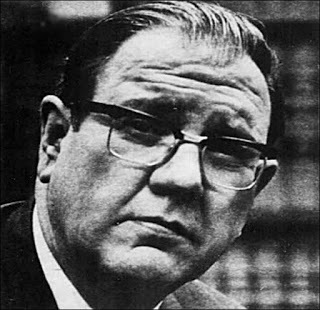 Defense lawyer Joseph Louisell
Defense lawyer Joseph LouisellLouisell was a popular customer at the Lindell AC. He was a heavy set, jovial man who was well-read and an avid sports fan. Louisell was known for winning some of Detroit's most notorious cases. He earned respect for bringing acquittals or reduced sentences for many local crime figures. He lived in the same Grosse Pointe Park neighborhood with many of Detroit's top-ranking mob figures. Their kids even went to school together.
"I want to talk with you about your suspension, Alex. The NFL meets in Miami next month. Have you made any plans regarding your reinstatement?"
"No, Rozelle wants me to drop my interest in the bar and I can't afford to do that."
"I've thoroughly checked out your bar activities.... You're as clean as snow."
"Tell that to Rozelle!"
"Give me the okay and I'll represent you."
"I can't afford you, Joe."
Over 65% of Joseph Louisell's law practice was devoted to civil and corporate law. That's how he and partner Ivan Baris made their money, but that bored Louisell. Joe would take some cases pro bono (free) if they interested him. Winning several high-profile defense cases helped build his reputation. Louisell was a diehard Lions fan, as were other interested parties who wanted to see Karras back in a Lions uniform, but they preferred to remain anonymous not wanting to prejudice the case against him.
"I'll take your case pro bono. I want to see you back on the gridiron, Alex. Here's my argument."
Louisell cited a provision in Michigan liquor licensing that states if your name appears on a Michigan liquor license, you can't sell your business for one year--by law. That includes taverns and liquor stores.
"What does that mean for me?"
"Were you to sell your interest in the bar business, you can 't get another liquor license for three years. We can sue them for lost wages if they force you to sell the Lindell and they don't reinstate you."
Louisell told Alex to quit working at the bar, return to his family in Clinton, Iowa, maintain a low profile, and most of all, not to speak with the press. "Wait for my phone call," Louisell emphasized. In late January, Louisell made sure Karras' formal reinstatement appeal was on Commissioner Pete Rozelle's desk.
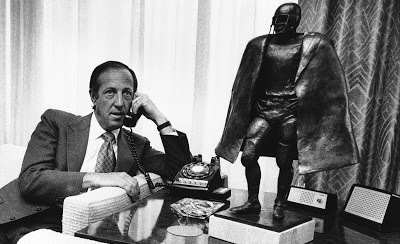 NFL Commissioner Pete Rozelle
NFL Commissioner Pete RozelleIn early March, Louisell and Karras went to meet with Commissioner Rozelle at his New York offices. After waiting for almost an hour in a reception room, the two men were led into the commissioner's office where Rozelle on the phone ignored them for some minutes. With Karras about to walk out of the office in frustration, Louisell calmed him down and told Rozelle to get off the phone, "This man's life is important."
"Okay, Mr. Louisell, I'm listening."
Louisell began to explain that gambling is as intrinsic to professional football as the two-pointed pigskin and Rozelle knew it. NFL football gambling existed on every level of American society and occurred weekly in office and factory pools, in Las Vegas sports betting parlors, and with private wagers made by John Q. Public--most of it innocent enough.
"You've unjustly punished Alex Karras for a year. My advice to you is make a decision within a week. If it's negative, I will tear the NFL apart." Louisell and Karras rose promptly from their seats and left the commissioner to think it over.
Rozelle knew any bad publicity with a headline-hungry press was not good for the league. He also knew that Louisell was not some ambulance-chasing shyster. His client list included many of Detroit's most notorious power-players including Jimmy Hoffa, Teamsters president. The last thing the NFL wanted was a media circus broadcast nationwide.
On March 16, 1964, both Green Bay Packer Paul Horning and Detroit Lion Alex Karras were reinstated. The NFL issued a statement saying both men bet on football games but never against their own teams, and there was no evidence either man performed less than his best in any football game.
"After personal discussions with each man, the commissioner is satisified that they have a clear understanding of the seriousness of their offenses," said an NFL spokesman. Nothing was mentioned about Karras' co-ownership of the Lindell AC sports bar.
***
In a 1969 interview with Sport magazine writer Lou Proto, Karras was led into the subject of his 1963 suspension. "It is my understanding," said Proto, "that you had to sell your interest in the Lindell AC when ordered by Pete Rozelle."
"I kept it for five more years."
"How did you manage that?"
"It was a verbal thing. If Rozelle would have claimed something illegal was going on at the Lindell, he would have been slapped with a lawsuit."
"Then, you were lying when you told Rozelle in 1964 that you sold your interests in the bar?"
"Lying to whom? The guy who was trying to screw me?"
Karras was outspoken but not altogether candid in the interview. He didn't care; he knew the end of his football career was near, and he had already shifted his career trajectory into show business by signing a contract with Hannah-Barbera Productions--appearing in the TV series Daniel Boone with Fess Parker and a western named The Hard Case with Clint Walker.
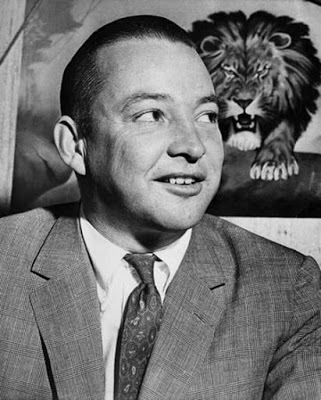 William Clay Ford
William Clay FordRecently, Mel Butsicaris revealed to me what really happened. His father Johnny went to see Lions owner William (Bill) Clay Ford. He told Bill Ford if he ever wanted to see Karras in a Lions' uniform again, he needed to lend him and his brother Jimmy the money to buy out Karras' share of the Lindell. They put up their sports bar as security, cut a deal, and Ford had his lawyers write up the promissory note. It took the Butsicaris brothers five years to pay off the loan.
"My dad paid the last installment to Bill Ford personally and took the promisory note, twisted it up, and set one end on fire to light his cigar."
Although I can appreciate the symbolic gesture, the researcher in me regrets that this piece of documentation when up in smoke.
More background on Joseph Louisell
September 23, 2020
Alex Karras' NFL Gambling Suspension--Part Two of Three
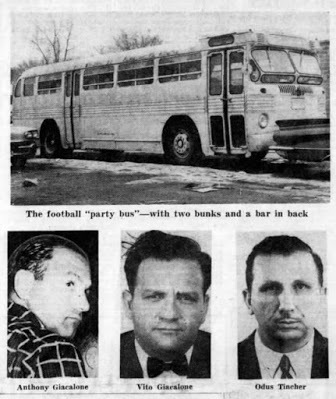 Anthony Giacalone - Vito Giacalone - Odus Tincher
Anthony Giacalone - Vito Giacalone - Odus TincherOn August 18, 1962, Detroit crime figures Tony and Vito Giacalone and a few of their friends--including Jimmy and Johnny Butsicaris--went to Cleveland in their private bus to see the Lions play the Browns in an exhibition game. Jimmy and Johnny shared the driving chores. After the game, Jimmy invited Alex Karras and his teammate John Gordy to return to Detroit on the luxury bus instead of uncomfortable team-provided transportation. As team protocol required, they asked Lion's head coach George Wilson for approval, which he gave.
Karras and Gordy entered Vito Giacalone's renovated Detroit Street Railways (DRS) bus. The exterior was painted in the Detroit Lion's team colors of silver and Honolulu blue. The inside of the former municipal bus was gutted and refurbished with two comfortable couches set across from each other between the bus's doors. A rectangular table could be lowered between the couches from the ceiling for eating or playing cards. A compact bar and a curtained platform with a double bed was situated in the back of the bus. Giacalone was permitted to park the bus behind the Lindell AC when not in use. In return, Jimmy and Johnny occasionally borrowed the bus for family vacations. It was a simple handshake agreement among friends.
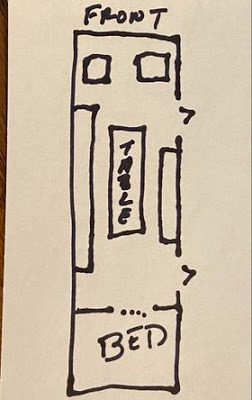 Bus layout sketch by Mel Butsicaris.
Bus layout sketch by Mel Butsicaris.The football players were welcomed aboard with a chilled beer before settling in to play cards for the return trip to the Lindell AC, with an FBI cruiser tailing them all the way back to Detroit. The next morning, Lions' general manager Andy Anderson summoned Karras into his office.
"The FBI reported to Police Commissioner Edwards that you and John Gordy rode back from yesterday's game in a 'party bus' with undesirable elements who do not belong in a professional football player's life. Your bar partners--known gamblers--were also on the bus."
"So what?"
"We've had this conversation before, Karras. Drop your interest in the Lindell AC. That's final!"
"Mr. Anderson, do me a favor."
"What?"
"Trade me!"
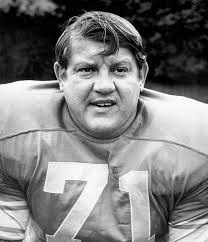 Alex Karras--Just a pawn in a world he didn't understand?
Alex Karras--Just a pawn in a world he didn't understand?On January 9, 1963, The Detroit News broke the story of the "hoodlum-operated party bus." The next day, NBC News wanted to interview Karras about the bus ride and the gambling charges that they discovered the NFL was investigating.
The Butsicaris brothers counseled Alex against granting the interview, but he was characteristically headstrong. Karras was guileless and expected everyone else to be that way. With the conviction of the righteous, Karras agreed to the NBC interview which was taped on January 13th. Towards the end of the thirty-minute interview, Karras was asked if he ever bet on sporting events. He glibly answered, "Yes, I do, with my brothers for a cigar or a pack of cigarettes."
When the interview was edited for broadcast, all that anybody heard was the sound bite of Karras answering "Yes, I do" coming from his own mouth. From there, the quote went to the wire services and was distributed nationwide to newspaper, radio, and television outlets. Alex was blindsided by NBC News.
With the end of the regular season, NFL commissioner Pete Rozelle, a league attorney, and a stenographer held a meeting with Karras. Alex believed gambling was a part of Greek ethnic character. From the age of fifteeen, he hung out with his older brothers in the Fifth Avenue Pool Room in Gary, Indiana. He bet on pool and played cards for entertainment. Everyone he knew did. "I never thought it was sinful and never attempted to hide it or felt the need to do so," he explained to Rozelle.
"Did you ever gamble on NFL games?"
"Never more than $50 a game and never against the Lions. I haven't thrown any football games, and I don't have ties with gangsters. This whole incident is being blown out of proportion."
Even after offering to take a lie-detector test, Karras was suspended for the 1963 football season and fined $2,000 for betting on the Green Bay Packers/New York Giants championship game. The Detroit Lions were fined $4,000 for minimizing information concerning "undesirable associations" and allowing questionable people to sit on the Lions' bench during games.
The Lions' fine was aimed directly at Jimmy Butsicaris, who was often seen on the bench. In addition to being a tavern owner, Jimmy had a weekly radio sports show in Detroit called Sportstalk on WXYZ-AM radio. He had a press pass authorizing him to have team and field access.
Karras told a Detroit Free Press reporter on January 18, 1963, "I must be the most naive guy in the world. How could I get myself in a mess like this when I know I didn't do anything wrong?" In the meantime, Karras settled into his suspension and learned the bar business from the ground up.
End of Part Two



